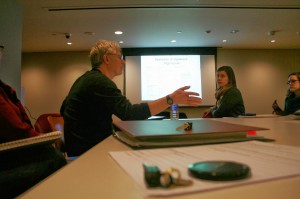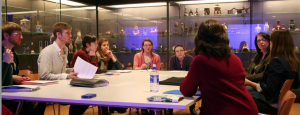Over the past week UW-Madison has been host to a couple of events that have helped to continue what is arguably the most notable and far reaching aspect of Indian cultures: oral traditions. Through the practice of storytelling, the Native tribes of Wisconsin are able to spread and teach their philosophies and histories while also giving thanks and meaning to life.
 On Thursday, February 6th, the Chazen Art Museum had a reception for the latest exhibit titled, “Changing Hands: Art Without Reservation 3, Contemporary Native North American Art from the Northeast and Southeast.”
On Thursday, February 6th, the Chazen Art Museum had a reception for the latest exhibit titled, “Changing Hands: Art Without Reservation 3, Contemporary Native North American Art from the Northeast and Southeast.”
Those who attended had the opportunity to watch a native ceremonial opening by the Wisconsin Dells Singers, a Ho-Chunk family who performed various songs and dances. Elliott Funmaker led the ceremony and gave an introduction to the history of each song and dance.
Initially I was very surprised at how relaxed and light hearted the Wisconsin Dells Singers treated the event for displaying their sacred traditions. Elliott’s confident yet inviting presence allowed for a more engaging experience, and the genuine smiles of his family served as reminders that our curiosity was welcome. The occasional quip with tasteful humor seemed to ease any last bit of tension that the crowd may have had, making for an insightful and positive experience. To end the ceremony Elliott invited any and all to come up and chat with the performers.

In the past these oral experiences may have been limited to visitors and members of the tribe, but times have changed. Prior to the ceremonies at the Chazen Art Museum, Rand Valentine, Professor of Linguistics and Director of American Indian Studies at the University of Wisconsin-Madison, gave the TLAM class some insight as to the kinds of challenges that Native oral traditions are facing.
In particular, Rand focused on the marginalization and demise of most Native languages, which largely results from the homogenization of language in an interconnected world economy. Rand went on to explain what kinds of steps he has taken to help preserve the languages he has worked with in the past.
It may come as no surprise that language preservation is a tough issue to tackle. Over the first few weeks of class, the students of TLAM have been focusing on just this. How can libraries, archives, and museums work in cooperation with local Indian nations to help preserve existing languages?

To go a step further, the students of TLAM have been ask the question of whether or not language revitalization is a viable option. While the answers to these questions are not always clear, the likely truth is that the greatest potential for success lies in some level of cooperation between Indian nations and their surrounding communities. The ceremonial display at the Chazen Art Museum is an indicator of one way in which healthy relationships can be built to increase future cooperation.
More recently it seems that times are changing for the better. An audience that largely alienated Native cultures just a generation or so ago is now benefitting from a level of mutual acceptance. The greater part of America now has the opportunity to further gain the intellectual and social benefits that come from experiencing the oral traditions of Native cultures. In return, the Indian nations of America have firmer ground to stand on from which they can finally begin to revitalize and rebuild, in hopes of one day fully regaining their cultures.
-Jacob Baker
